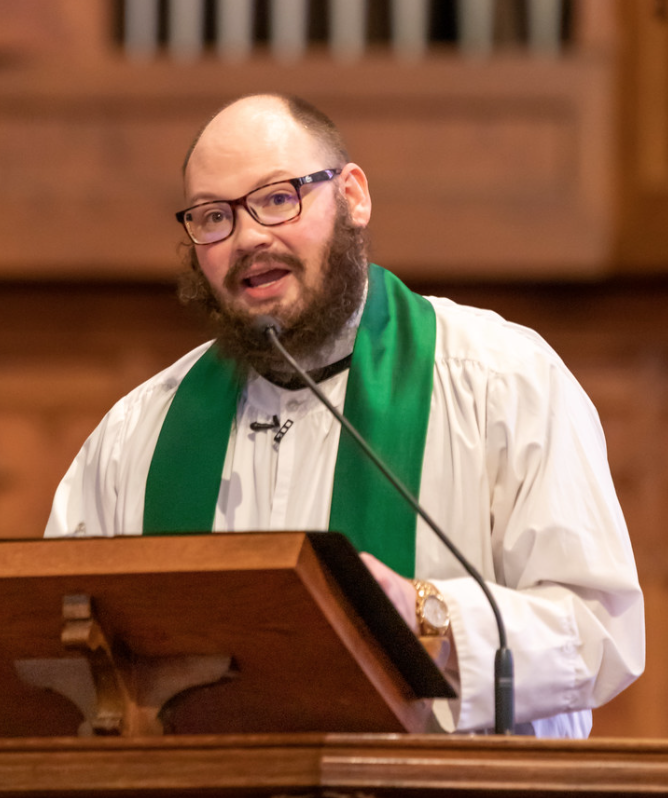
Rev. Cn. Richard Hogue
Ah, the “cleansing of the Temple.” This is a text that I had loved and relied on for a long time. It makes a case for righteous indignance and gives those that wield it an angry Jesus to follow and chase out things that we think are contrary to the work of God. But the more I read it the more baffling it becomes. When I put my bafflement about it into conversation with what we know about Jesus the person, archaeology, and the historical context of Christian supersessionism, the greater my concern grows.
Supersessionism, or replacement theology, is the idea that Christians superseded or replaced the nation of Israel, assuming the Israelite role as God’s covenanted people, asserting that the New Covenant through Jesus Christ has replaced the Mosaic covenant. Even if we say we don’t subscribe to this theology, the way we speak about the “Old Testament” versus the “New Testament”, or the “God of the Old Testament” versus “The God of Jesus” points to this underlying assumption. If we wish to avoid that, we should call Hebrew Scripture what it is, Hebrew Scripture.
There are some befuddling things about this in and of itself, like the fact we use Hebrew Scripture to justify and promulgate that idea Jesus was prophetically destined to undo his own people’s belief system. It’s even more perplexing if we consider Jesus’ divinity as the incarnate God of the Hebrews. Add to that the theological assumption that God is immutable, unchangeable, yet God plans to make wholesale changes to salvation and renege on all God’s promises to Jewish people who followed those commandments as a sign of their blessing, it’s a pretty dangerous house of cards we build to make ourselves appear superior to our ancestors in faith. Given the historic atrocities of the church against Jews, this should give all Christians a moment of perilous pause.
In the same way we scrutinize Hebrew Scripture, everything I am about to put forward is based on research, prayer, discernment, and a desire to walk closer with Jesus. I’m going to do unto ourselves as we do unto others. Turnabout is fair play. It may sting a bit, but I hope it will ultimately be as freeing as an act of contrition and repentance, flipping a stone that builders have rejected into a new cornerstone. That seems like a worthy thing in Lent. Are we ready? [visibly crack knuckles] Let’s go.
The first thing that makes little sense about this story in John’s retelling of the cleansing of the Temple is that it happens after the wedding of Cana, in the earliest stages of Jesus’ ministry opposite the other three gospels, which place this story at the week of his death. The important literary and historical context to remember is how far apart John’s Gospel is from Jesus when he was alive. From all the evidence currently available, the Gospel of Mark was the first written, likely between 66-70 CE, then Matthew and Luke’s between 85-90 CE, and John’s between 90-110 CE. Considering most people would be exceedingly lucky to live into their mid-30s in this era, it becomes obvious that if Jesus was crucified by the Romans between 30-36 CE then Mark was written at least a full generation after Jesus’s death. It’s more like three or four for John. The Romans besieged and utterly decimated Jerusalem and the Temple in 70 CE, it was genocide on a massive scale.
Another oddity of John’s version is the redundancy of phrase “The Passover of the Jews.” This likely indicates a lack of understanding of Judaism given the generational separation from Jesus and the disciples. In all the other gospels, Jesus goes up to the Temple as a pilgrim, but for John it’s a chance for Jesus to begin protesting. One can’t simply explain these differences away as merely “John’s perspective,” because John shares most other details with the other gospels.
Knowing these key differences between John and the other gospels, we can begin to ask bigger questions about the entire story. Let’s start with what we know about Jesus the person. Jesus was Jewish, Jesus was very Jewish, Jesus was very very very Jewish. He was born of the royal Davidic bloodline and raised in a practicing Jewish household. He ate, slept, read, lived, and died by Hebrew Scripture like Canadians love hockey. It was his whole world, everything he ever knew, the entire basis of his existence. He wore a prayer shawl, referenced in the story of the hemorrhaging woman (Luke 8.44), he was constantly hanging around the Temple as a youth in Matthew, and frequently argued with his fellow Jewish teachers, the Pharisees, because he was always around them.
We also know he lived in Judean Palestine. That means he was a pilgrim frequently in his life during Passover, that he knew the look, smell, sounds, and feel of the holiest day in the holiest place of his people in a bodily way. Neither Passover nor Temple observance were abstract concepts for Jesus, it was a vital and lived practice of God’s freeing of his people Israel from another oppressive empire in Egypt. The similarities between his people’s experience with Egypt and Rome would not have been lost on him. Further, if we take Jesus’ divinity seriously in that context, then Jesus was literally God conforming to his own commandment to his own people to celebrate the Passover and to keep it holy. None of this is to say that Jesus couldn’t have had critiques of Temple leadership, but the basics of the Temple’s purpose and culture were part of who he was.
Let’s move to what we know about the Temple in Jerusalem before its Roman obliteration. According to archaeological evidence, the Temple was built to hold 75,000 people at once.[1] The “Court of the Gentiles,” where sacrificial animals were sold, was enormous, around 1,200 feet long and surrounded the inner courts, and was walled in and covered by porticos surrounding the outer edge.[2] The selling of the animals there would be a service to those coming great distances, and there would be tens if not hundreds of thousands more people in Jerusalem that week than the rest of the year. Roman coins weren’t allowed into the Temple because of the graven images of Roman emperors on them, violating the first commandment since Roman emperors were considered Gods by Romans. People would exchange them just outside the temple for Phoenician coins.[3] Jesus wouldn’t have been upset with people following the practices that God instructed, and certainly not as God himself. The Temple tax was also miniscule, capped at 4% of the total exchange for building maintenance. The prices were fixed, there was no haggling, so there wouldn’t be reason to be upset over this.[4]
If Jesus was being as disruptive as the Gospels purport him to be, then why didn’t Roman police, Temple police, any of the religious authorities, or any other faithful pilgrims stop him? And given the rather small entrance gates relative to the inner size of the Temple courts, how did he alone clear out the entire Court of the Gentiles?[5] Think again of its size! How could Jesus, who had been a pilgrim himself time and again, either as a faithful person or as God among his people Emmanuel, object to any of the practices and commandments he himself practiced or commanded as God? It doesn’t fit in Jewish logic, or the immutability of God’s promises, archaeological evidence, or practical evidence. Teaching and arguing were certainly things he would have done there, but violently driving all those animals and people away makes little sense based on what I understand…
Unless… Unless we take a step back to where we started, the theology of supersessionism. Looking at this story through the lens of people who’ve lost touch with Jesus’s Judaism, who’ve never known the temple because it was destroyed, who viewed Jews as competitors and Romans through the eyes of persecution and blood, then, and only then, does this story begin to make sense. I am becoming of the mind, like Origen of Alexandria, that this story never actually happened. Origen interpreted it as a symbolic commentary directed at the church, which could certainly be true, the Temple standing in for our own institutions. Historically, I see it as early gentile Christians cleansing themselves of any remaining vestiges of Jewish practice as the church drifted further into Roman hands.[6] Rome destroyed Jerusalem and the Temple. Christians cozied up to the powers and principalities of their own time, some of our ancestors in faith tried to dislodge the root of Jesse from its source, and this is just one example. Sadly, it’s only a stones throw from stories like the “cleansing of the Temple” to Kristallnacht, and so many other horrors in-between and after.
I know this is hard to hear. Believe me, it is hard to confront this in a faithful and public way. Our scriptures are as ripe for abuse as anything in the Hebrew Bible. Perhaps righteous indignation with our own tradition follows the footsteps of Jesus, and maybe facing it can open a path to healing beyond our own temple. Ultimately, I hope it helps us repent of the church’s many evils done in Jesus’ name, from anti-Judaism to American slavery and beyond, so we can begin building something more faithful to Jesus and his way of love. The world is too dangerous for anything else now. Amen.
[1] Nylund, J. 2016. “Court of the Gentiles.” In J. D. Barry, D. Bomar, D. R. Brown, R. Klippenstein, D. Mangum, C. Sinclair Wolcott, & W. Widder (Eds.), The Lexham Bible Dictionary Lexham Press/Logos. https://portal.research.lu.se/files/57820558/Court_of_the_Gentiles_m_fr.pdf Accessed 3/2/2024.
[2] Ernst Haenchen. 1984. John: Chapters 1-6—Hermeneia—A Critical and Historical Commentary on the Bible. Translated by Robert W. Funk. Edited by Robert W. Funk and Ulrich Busse. Fortress Press. p 182.
[3] “The Second Temple.” 2016. Jewishvirtuallibrary.org. 2016. https://www.jewishvirtuallibrary.org/the-second-temple. Accessed 3/2.2024.
[4] John. 183.
[5] Ibid., 188.
[6] Ibid.,

